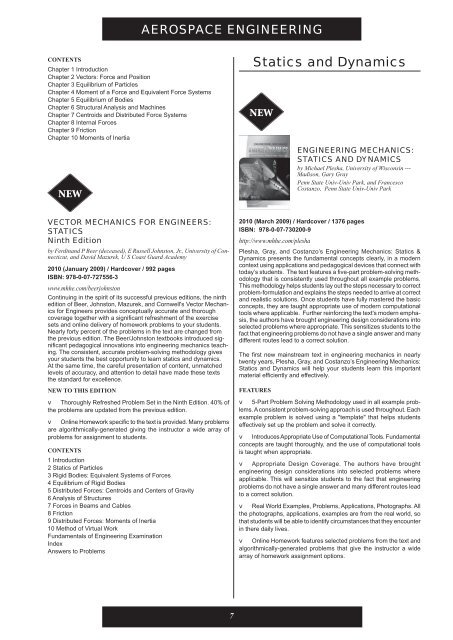Download - McGraw-Hill Books
Download - McGraw-Hill Books
Download - McGraw-Hill Books
You also want an ePaper? Increase the reach of your titles
YUMPU automatically turns print PDFs into web optimized ePapers that Google loves.
AEROSPACE ENGINEERING<br />
CONTENTS<br />
Chapter 1 Introduction<br />
Chapter 2 Vectors: Force and Position<br />
Chapter 3 Equilibrium of Particles<br />
Chapter 4 Moment of a Force and Equivalent Force Systems<br />
Chapter 5 Equilibrium of Bodies<br />
Chapter 6 Structural Analysis and Machines<br />
Chapter 7 Centroids and Distributed Force Systems<br />
Chapter 8 Internal Forces<br />
Chapter 9 Friction<br />
Chapter 10 Moments of Inertia<br />
NEW<br />
Statics and Dynamics<br />
NEW<br />
ENGINEERING MECHANICS:<br />
STATICS AND DYNAMICS<br />
by Michael Plesha, University of Wisconsin ---<br />
Madison, Gary Gray<br />
Penn State Univ-Univ Park, and Francesco<br />
Costanzo, Penn State Univ-Univ Park<br />
VECTOR MECHANICS FOR ENGINEERS:<br />
STATICS<br />
Ninth Edition<br />
by Ferdinand P Beer (deceased), E Russell Johnston, Jr., University of Connecticut,<br />
and David Mazurek, U S Coast Guard Academy<br />
2010 (January 2009) / Hardcover / 992 pages<br />
ISBN: 978-0-07-727556-3<br />
www.mhhe.com/beerjohnston<br />
Continuing in the spirit of its successful previous editions, the ninth<br />
edition of Beer, Johnston, Mazurek, and Cornwell's Vector Mechanics<br />
for Engineers provides conceptually accurate and thorough<br />
coverage together with a signifi cant refreshment of the exercise<br />
sets and online delivery of homework problems to your students.<br />
Nearly forty percent of the problems in the text are changed from<br />
the previous edition. The Beer/Johnston textbooks introduced signifi<br />
cant pedagogical innovations into engineering mechanics teaching.<br />
The consistent, accurate problem-solving methodology gives<br />
your students the best opportunity to learn statics and dynamics.<br />
At the same time, the careful presentation of content, unmatched<br />
levels of accuracy, and attention to detail have made these texts<br />
the standard for excellence.<br />
NEW TO THIS EDITION<br />
v Thoroughly Refreshed Problem Set in the Ninth Edition. 40% of<br />
the problems are updated from the previous edition.<br />
v Online Homework specific to the text is provided. Many problems<br />
are algorithmically-generated giving the instructor a wide array of<br />
problems for assignment to students.<br />
CONTENTS<br />
1 Introduction<br />
2 Statics of Particles<br />
3 Rigid Bodies: Equivalent Systems of Forces<br />
4 Equilibrium of Rigid Bodies<br />
5 Distributed Forces: Centroids and Centers of Gravity<br />
6 Analysis of Structures<br />
7 Forces in Beams and Cables<br />
8 Friction<br />
9 Distributed Forces: Moments of Inertia<br />
10 Method of Virtual Work<br />
Fundamentals of Engineering Examination<br />
Index<br />
Answers to Problems<br />
2010 (March 2009) / Hardcover / 1376 pages<br />
ISBN: 978-0-07-730200-9<br />
http://www.mhhe.com/plesha<br />
Plesha, Gray, and Costanzo’s Engineering Mechanics: Statics &<br />
Dynamics presents the fundamental concepts clearly, in a modern<br />
context using applications and pedagogical devices that connect with<br />
today’s students. The text features a five-part problem-solving methodology<br />
that is consistently used throughout all example problems.<br />
This methodology helps students lay out the steps necessary to correct<br />
problem-formulation and explains the steps needed to arrive at correct<br />
and realistic solutions. Once students have fully mastered the basic<br />
concepts, they are taught appropriate use of modern computational<br />
tools where applicable. Further reinforcing the text's modern emphasis,<br />
the authors have brought engineering design considerations into<br />
selected problems where appropriate. This sensitizes students to the<br />
fact that engineering problems do not have a single answer and many<br />
different routes lead to a correct solution.<br />
The first new mainstream text in engineering mechanics in nearly<br />
twenty years, Plesha, Gray, and Costanzo’s Engineering Mechanics:<br />
Statics and Dynamics will help your students learn this important<br />
material efficiently and effectively.<br />
FEATURES<br />
v 5-Part Problem Solving Methodology used in all example problems.<br />
A consistent problem-solving approach is used throughout. Each<br />
example problem is solved using a "template" that helps students<br />
effectively set up the problem and solve it correctly.<br />
v Introduces Appropriate Use of Computational Tools. Fundamental<br />
concepts are taught thoroughly, and the use of computational tools<br />
is taught when appropriate.<br />
v Appropriate Design Coverage. The authors have brought<br />
engineering design considerations into selected problems where<br />
applicable. This will sensitize students to the fact that engineering<br />
problems do not have a single answer and many different routes lead<br />
to a correct solution.<br />
v Real World Examples, Problems, Applications, Photographs. All<br />
the photographs, applications, examples are from the real world, so<br />
that students will be able to identify circumstances that they encounter<br />
in there daily lives.<br />
v Online Homework features selected problems from the text and<br />
algorithmically-generated problems that give the instructor a wide<br />
array of homework assignment options.<br />
7

















